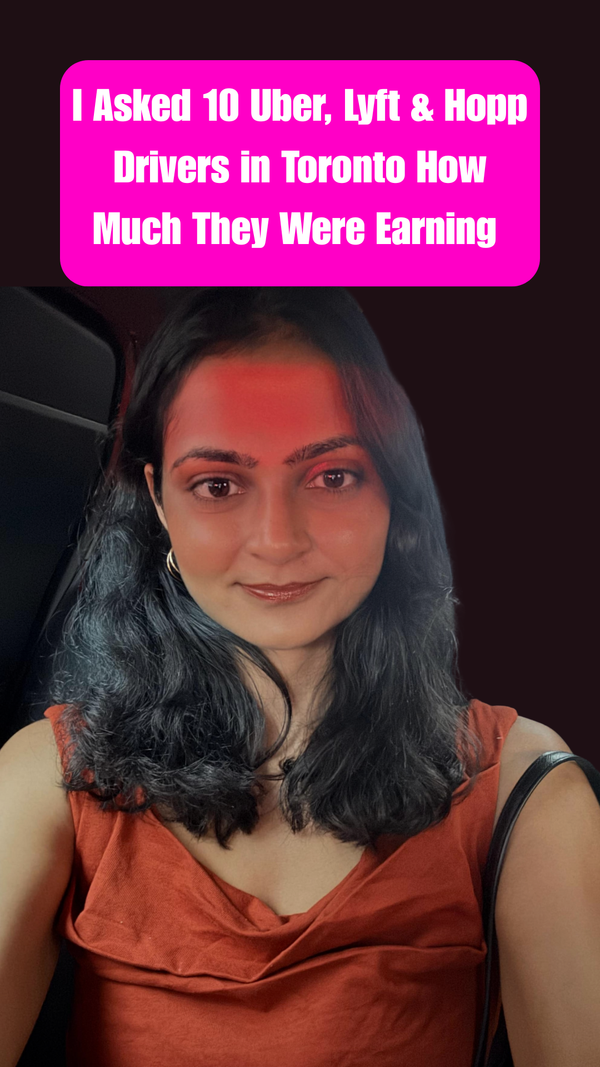Every time I order an Uber in Toronto, I feel the sting. Prices are higher than ever. But then I wonder: how much of that fare actually goes to the driver? Not the number Uber advertises or the hopeful guess your cousin throws around, but the actual amount that ends up in their pocket after gas, insurance, and car payments.
I decided to find out. Over one week, I jumped into multiple cab rides to ask the drivers directly. How much do you make before costs? How much is left after? Do people tip? Would you recommend this gig to a friend as a side hustle? Out of the twelve rides, ten drivers opened up and shared their stories with me. And the answers were far from what I expected.
Note: Names are included with people’s permission. Some drivers asked to remain anonymous, and their names have been omitted accordingly.
Ride 1: The Beginner Already Planning His Exit
My first ride was on Hopp with Hafiz, who had only been driving for two weeks after struggling to get his Uber account approved. This was his main income for now, though even he wasn’t sure how long he’d stick around.
On paper, Hafiz made about $250 in a 12-hour day. But even he knew the numbers didn’t add up once you factored in $300 a month for insurance, and on top of that, gas and car payments. My own ride cost a little over $9, and he only saw a fraction of it. His longest ride so far, from Markham to Pearson Airport, paid him $29. Tips don’t help much either; the most he’s ever seen was $5.
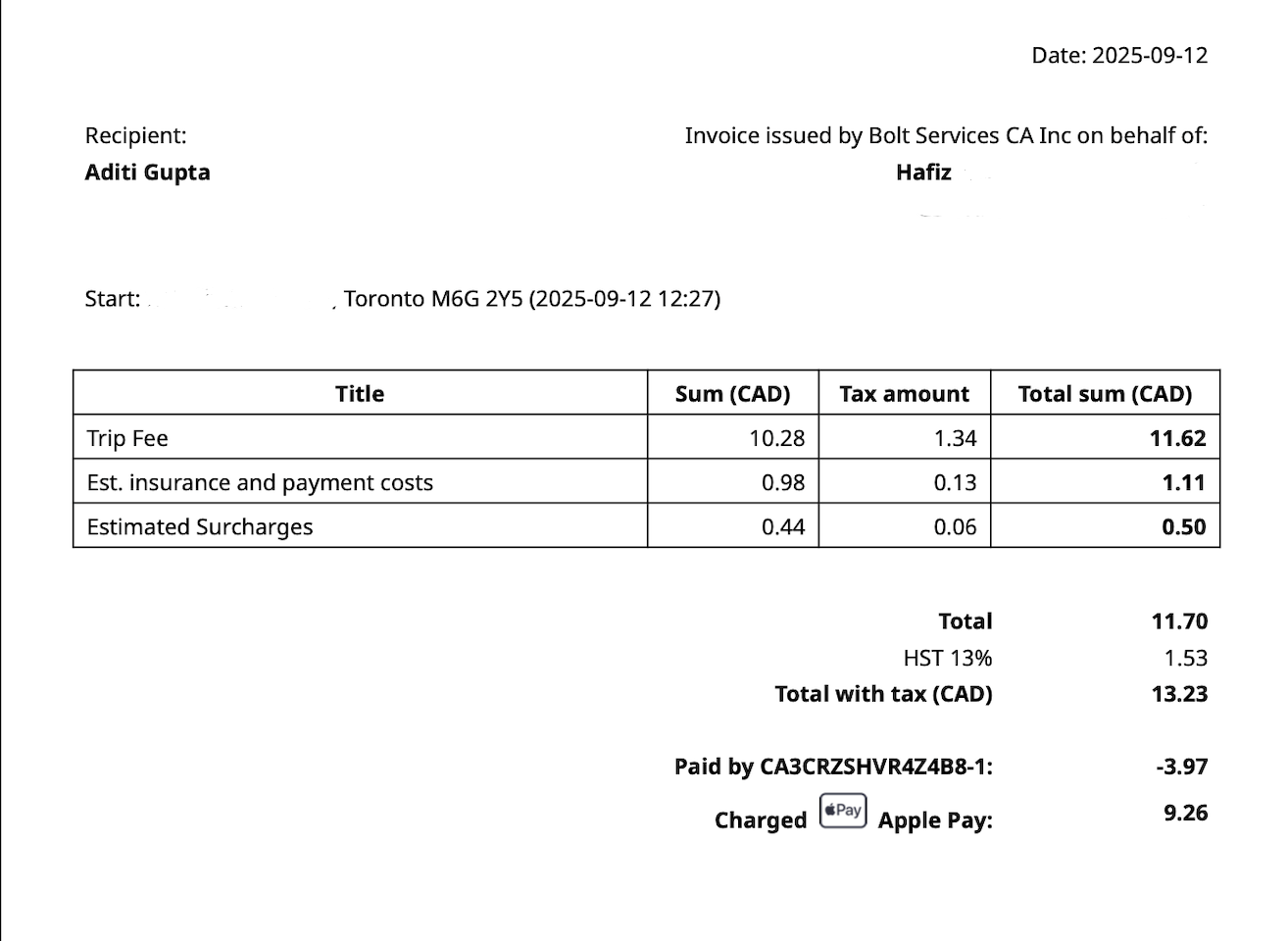
Before this, Hafiz tried Uber Eats, which he found slightly more profitable. But parking tickets and a flood of drivers chasing the same orders made it impossible. He admitted he was already looking for an exit. “I wouldn’t recommend this to anyone. Not even myself. As soon as I find something else, I’m gone.”
Ride 2: Eight Years in the Game
Daniel had been driving with Uber for eight years, practically a veteran in rideshare time. Before this, he worked in engineering and sales, but now Uber is his main income. He told the pay has dropped so much in the last few years that he often made less than $15 an hour. That’s below Toronto’s $17.60 minimum wage, and after car expenses, the number sinks even lower.
He blamed Uber’s new pricing system. Drivers now see the fare before booking, but they get a smaller cut. On my ride, I paid $14.61, but Daniel only received $6. The rest, he believes, gets eaten by Uber.
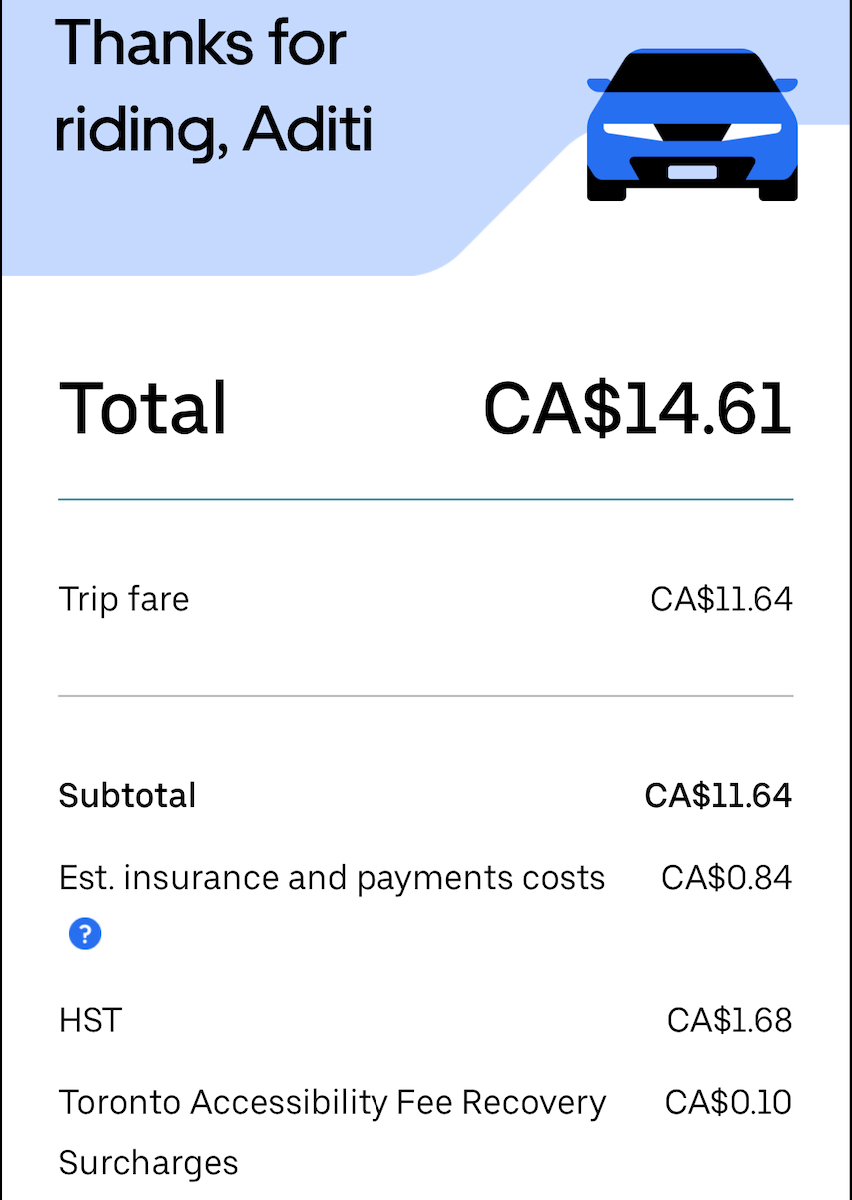
Tips don’t close the gap. Most people leave one or two dollars, and he has never seen more than $15 in tips. Longer drives, like trips to Kitchener or Barrie, used to pay fairly, but now the algorithm decides. “One day it says $100, the next day $80 for the same trip. There’s no logic.”
So why is he still driving? Bills. Daniel tried taking a month off, but quickly fell behind on payments. He doesn’t recommend Uber anymore, even as a side hustle. “Before COVID, it was okay but now it’s insane. Costs are up, fares are down.”
Ride 3: Two Years Stuck in Survival Mode
The third driver had been with Uber for two years. He’d applied to nearly 2,000 jobs since moving to Canada, but nothing landed. Uber was the only option left.
He said he brings in about $15-20 an hour before costs. After gas, insurance, and car payments, that shrinks to $5-10. Over a month, his gross might hit $5,000, but nearly half of it vanishes. About $500 goes to insurance, $1,000 to gas, and the rest into maintenance and car payments.
“When I started, drivers kept 70% of the fare,” he said. “Now it feels like Uber keeps that much.” Tips don’t help much either, with maybe 20% of riders leaving a tip, of one or two dollars. In his experience, Uber Share was one of the few features that sometimes felt worth it, since picking up multiple passengers added up.
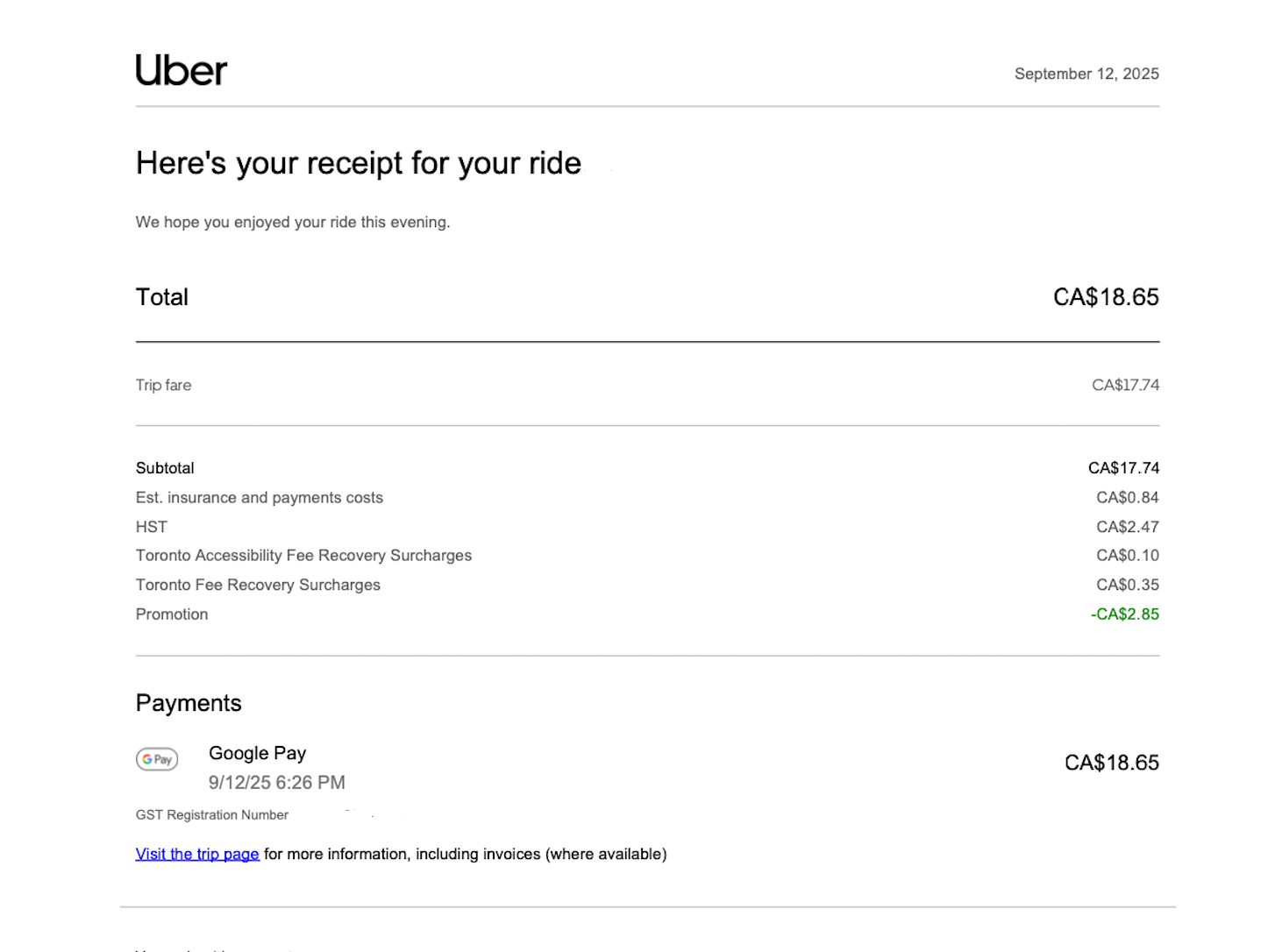
For one of his longest rides, from Pearson Airport to Sudbury, he earned $350, but had to drive back empty. By his math, the trip barely broke even. “It should’ve been at least $500,” he said. “We just want $1 a kilometre. Instead, we get cents. I’m only doing this because I don’t have another option.”
Ride 4: Freedom, But at a Cost
Ehsan had been driving with Uber for a year and a half. It isn’t the ideal option for him, but he found it better than working under a boss.
On weekdays, he averages about $20 an hour, while weekends creep up to $25–30. My $18.69 ride, he said, would net him around $10. But the split feels worse outside downtown. A customer paid $45 to the airport, but he got just $20.
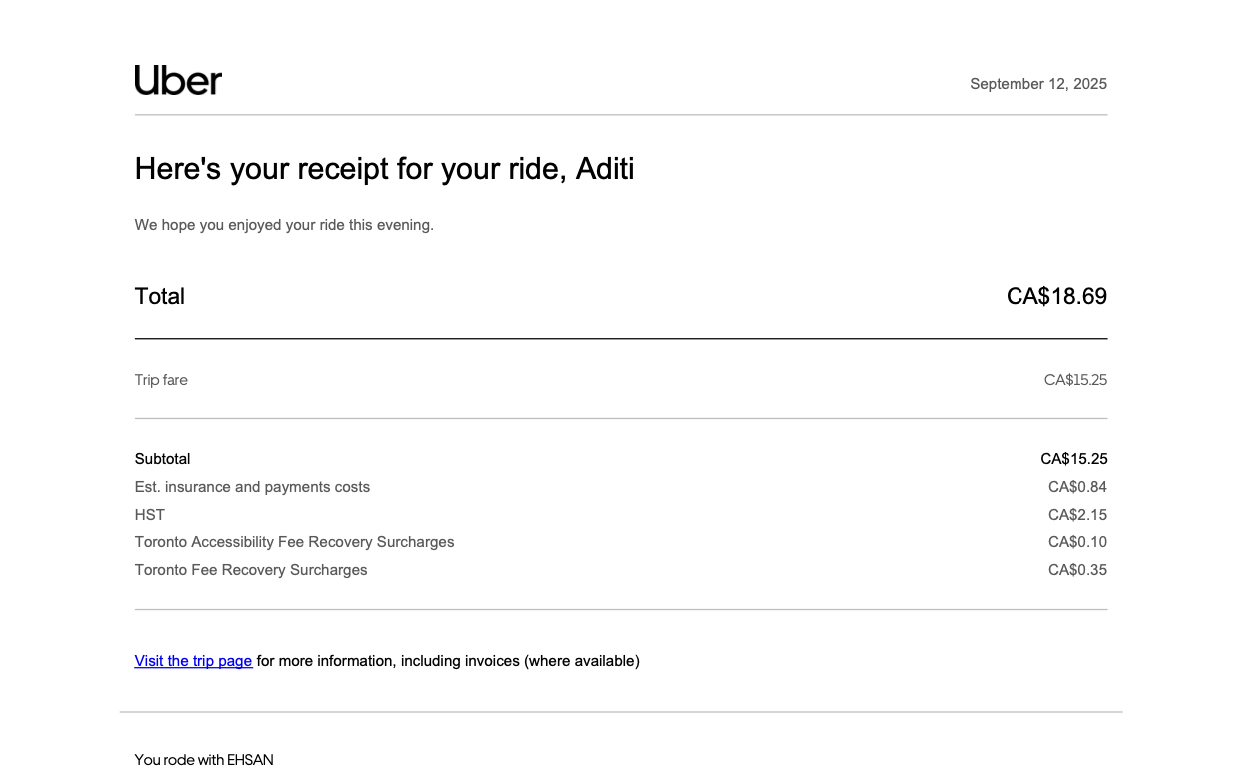
Tips sometimes soften the blow. His biggest was $60 on a $30 airport run from a businessman who was shocked at how little Uber paid him.
He told me about a new trend on long trips. A passenger might pay Uber $250 for a ride from Toronto to Kitchener, but he only gets about $150. Now some riders bypass the app entirely, offering to pay him directly instead. “They save, and I earn more,” he said.
Would he recommend Uber to others? “Depends,” he said. “I make $5,000 a month, but after car expenses, it’s far less. If you already earn that at a steady job, stick with it. But if you’re closer to $2,500 or $3,000, Uber might fill the gap.”
Ride 5: The Student Translator
A couple of rides later, I met a student from George Brown College who had been driving Uber for about two years. He drives part-time to fit around classes and his freelance work as a translator.
He earns around $20 an hour, but after all the car expenses, it drops closer to $12. What bothered him more was the long-term hit: “Uber kills the mileage on my car. The more I drive, the more it depreciates.” Tips rarely made a dent, with his best ever being $30. He also mentioned Uber’s much-touted Gold, Platinum, and Diamond tiers. They don’t mean better pay. It just means if you complain, they’ll answer you faster.
When I asked if he’d recommend Uber as a side hustle to others, he shook his head. “Not really, unless you don’t have another option.”
Ride 6: A Side Hustle With Too Many Tradeoffs
My sixth ride was just a quick errand to pick up my glasses, barely 2 km away, yet the fare came to $11.53. The driver, Haris, laughed when I mentioned it. “Out of that, I’ll see maybe half,” he said.
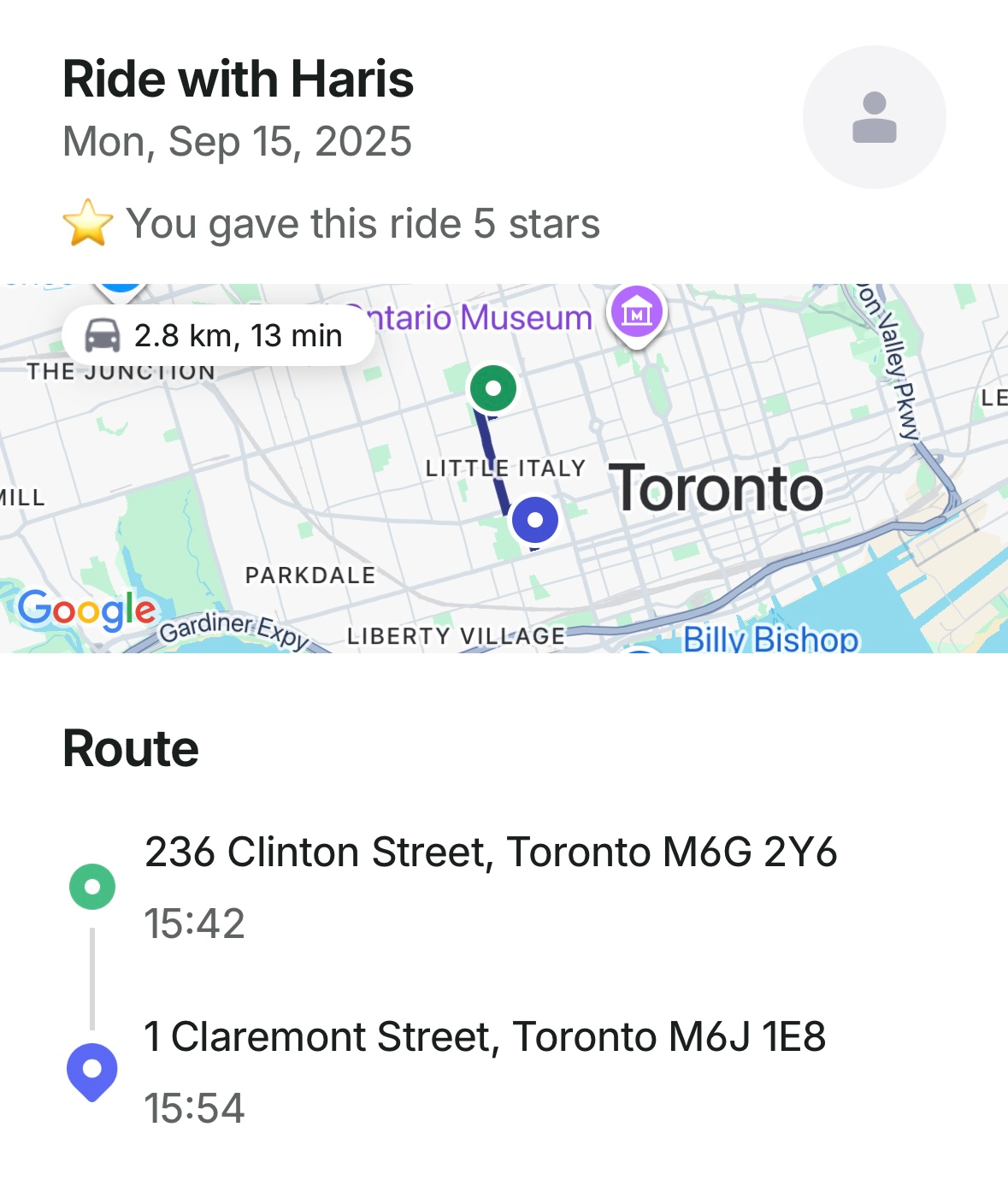
He’d been driving with Hopp for about six months, mostly as a side hustle to cover his car expenses while his real estate work slowed down. What struck me was how firmly he drew the line between rideshare and old-school taxis. “This isn’t cab driving,” he corrected me. “In taxis, the company owns the car and covers insurance. Here, everything is mine: the car, the gas, the liability. The company just takes its cut. It’s modern-day slavery.”
After expenses, Haris rarely got to keep $11 an hour. His longest trip, from Toronto to London, Ontario, was a perfect example of why he felt the system was broken. The ride stretched more than 180 kilometers and took over four hours, but paid him only $120.
His advice for people looking for extra income is to build skills instead, offer cleaning services, or sell something online, because this model doesn’t work.
Ride 7: The Lyft Driver Who Once Got a $500 Tip
MKY wasn’t like most of the other drivers I met, he already had a full-time job and drove Lyft on the side. He’d been doing it for about a year and told me he liked the flexibility better than Uber Eats or restaurant shifts.
The pay split is about fifty-fifty with Lyft. My $8.72 ride earned him roughly $4, and he told me that’s pretty typical unless it’s peak hours. On a good day, he can gross around $300 working 10-12 hours, though that’s before gas, insurance, and car payments.
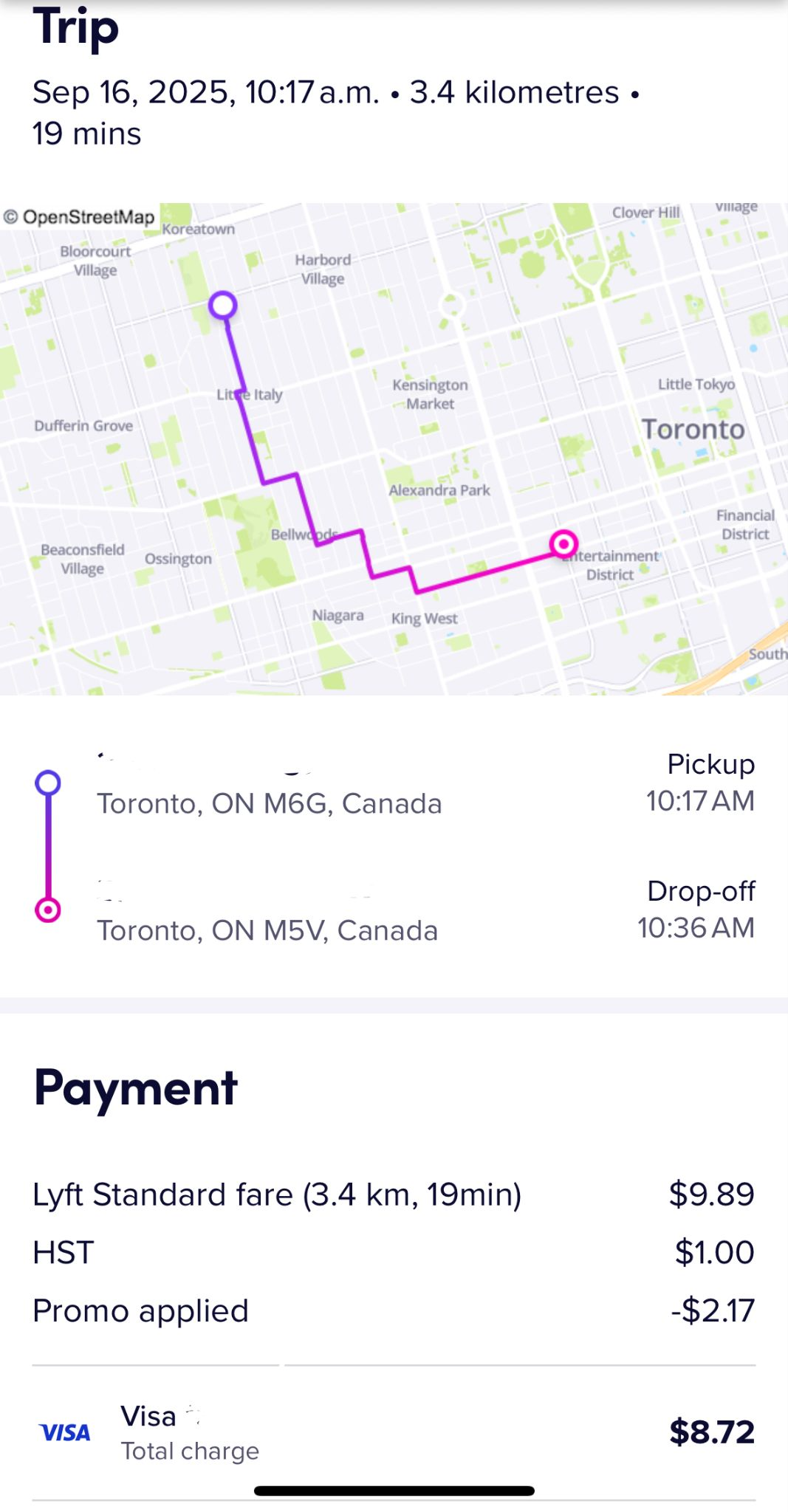
While tips are mostly amiss, MKY once scored a $500 tip from a wealthy passenger who just felt generous coming out of a casino. He definitely recommended it as a side hustle. But as a main income, it’s too hard.
Ride 8: “We’re Just Rotating Money”
The next driver, who picked me up for a short trip across downtown Toronto, has been driving full-time for Uber and Lyft for nearly two years. “We’re just rotating money,” he explained.“The money I earn, I spend it on gas, insurance, and car payments. Then I start the next day in the same spot.”
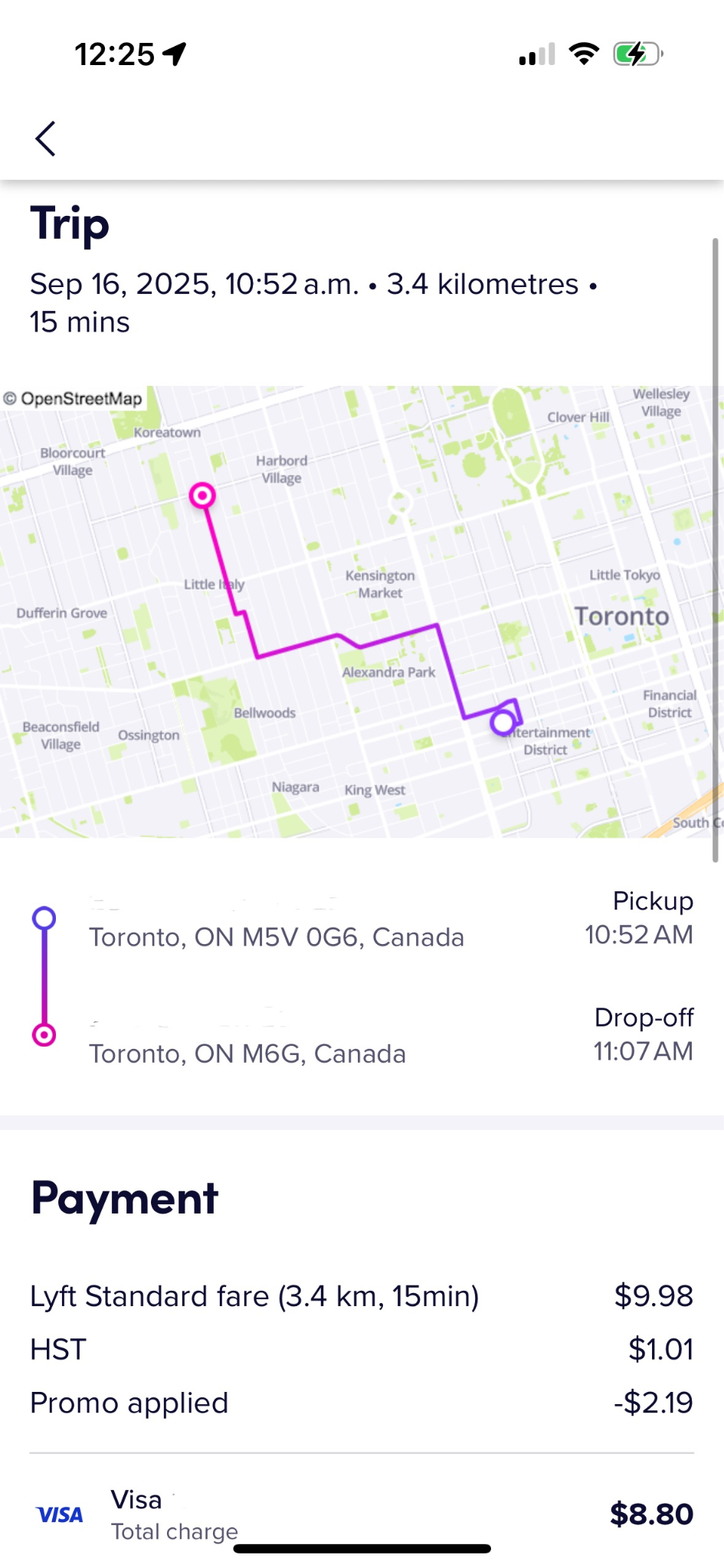
He’s learned that longer trips don’t always mean better pay. One ride to Blue Mountain earned him just $70 from Uber, even though it took hours and burned through gas. The passenger tipped him $30, which helped.
He’d experimented with other platforms, too. Uber Eats sent him 25 km for an $8 delivery. Hopp looked promising, but he quit after discovering hidden subscription fees and little driver support.
Would he recommend rideshare work? “Maybe as a second income, you might make enough for groceries. But don’t count on it to support a family.”
Ride 9: The Ex-Salesman Who Drives for Connections
Manjot turned to Hopp after being laid off from a tech sales job. He already found another job where he works 4 p.m. to midnight, so driving fits into his mornings.
On weekdays, a couple of hours nets him $50-60. On weekends, it’s more lucrative: 10–12 hours can bring in $300-400 before expenses. But gas and insurance eat into that fast. He figures gas alone costs $60–100 per shift, depending on how long he’s out. Still, he insists Hopp’s commission feels a little fairer than Uber’s. “On your $11 ride, I’ll keep around $7. But if it was a Monday morning, I’d get half of that.”
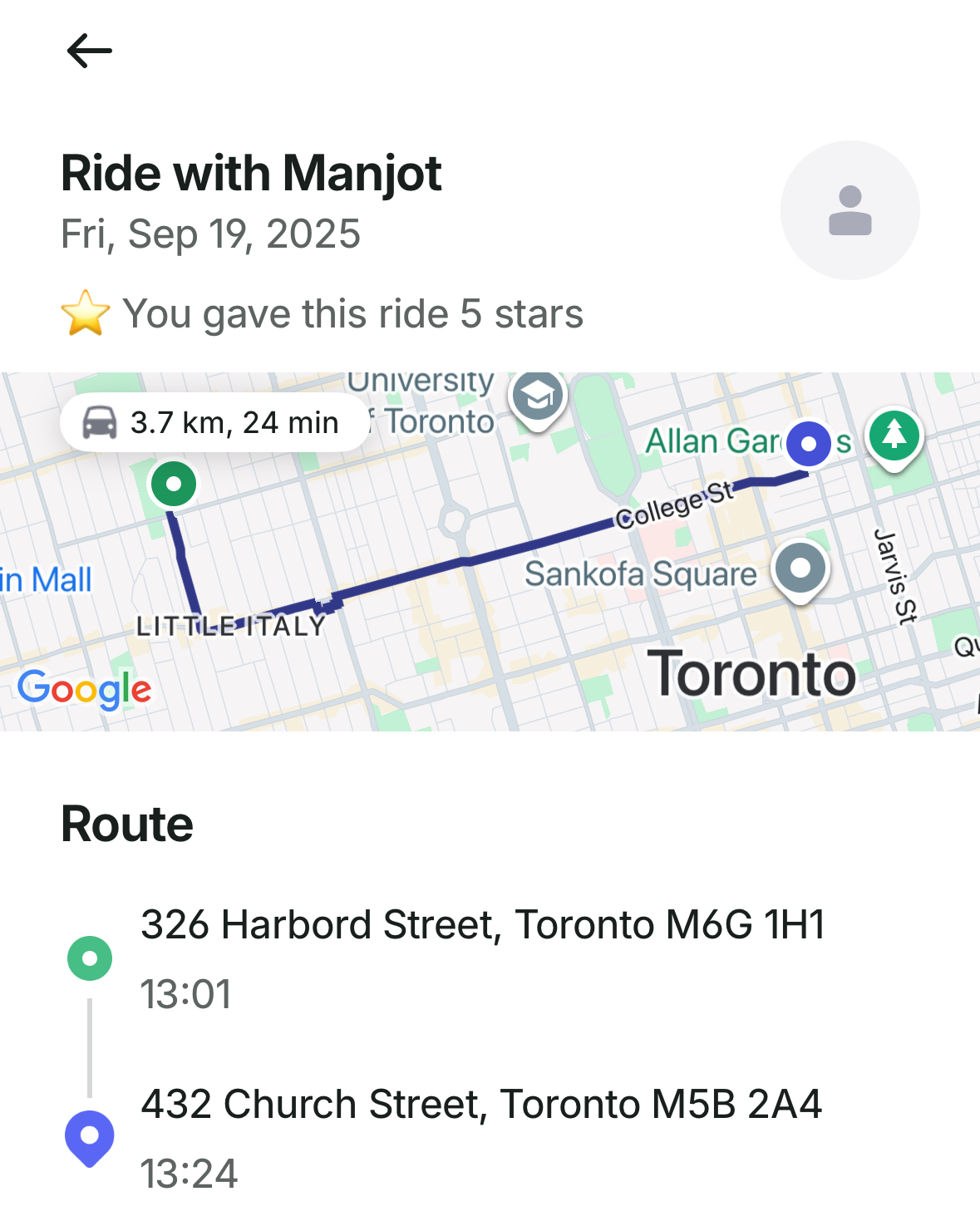
He doesn’t get many tips. “Last week, not even five bucks,” he said, showing his recent ride history. But one ride stood out- not for the money, but for the conversation. He picked up this guy who started talking about an app he built. “He showed me photos, told me about his India trip... turns out, he was the founder of Yuka.” The two ended up chatting about healthy food and the app’s growth.
Ride 10: “They Destroyed Taxis, Now They’re Destroying Us”
The last driver has been behind the wheel for more than a decade. He started with taxis and switched to Uber when it became “trendy,” but now regrets the switch. On my $11 ride, he said he’d only see $4 after Uber’s cut. “Taxi was better. At least the math made sense. Now we’re just subsidizing a billion-dollar company,” he told me, adding that Uber has raised passenger fares by almost 20% while cutting driver pay nearly in half.
Even tips are rare with Uber. Back when he drove taxi, everyone tipped. But now, maybe one or two people out of 15.
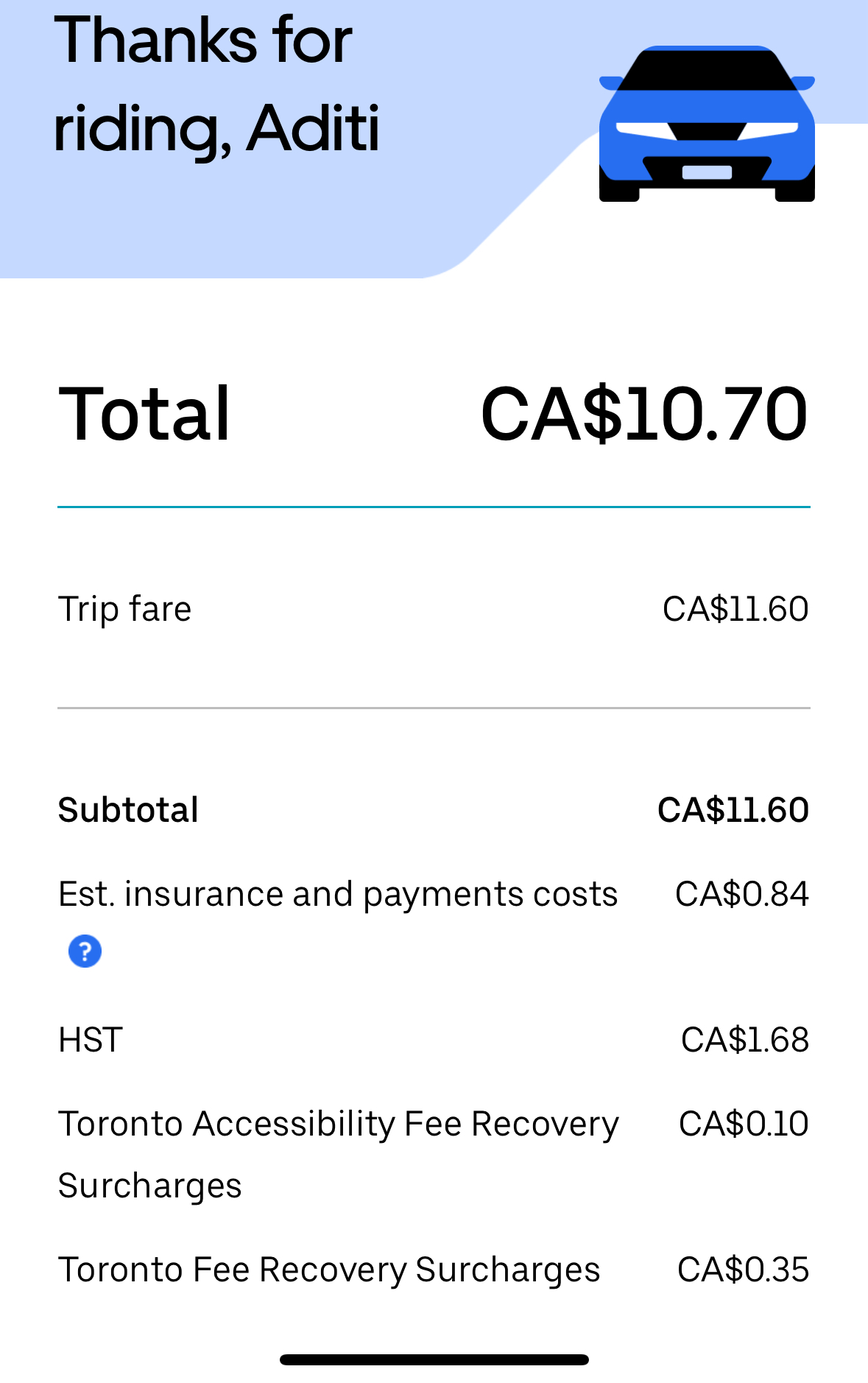
He also explained how Uber’s promised hourly minimum wage doesn’t work as people think. It only applies to the minutes a rider is in the car. So even if a driver is logged into the app and on the road for 10 hours, waiting for rides and driving to pickups, Uber only counts the four hours you had passengers with you. “When you factor in that, plus gas and expenses, I’m barely making $10 an hour.”
He wouldn’t suggest cab-riding to anyone- “It used to be a profession when I was driving taxi. Now it’s just survival.”
So, What Do Drivers Really Take Home?
Across the ten drivers I spoke to, the numbers were surprisingly consistent. Most said they grossed about $20 an hour on a normal day. But once gas, insurance, and car payments were factored in, their net hourly income slipped closer to $10-13.
These numbers are already well below Toronto’s $17.60 minimum wage, but still nearly double what the City of Toronto’s official report found. According to the 2024 report, rideshare drivers earned a net median of just $5.97 an hour once idle time and expenses were included. The report, based on 84 million trips and a survey of 1,000 drivers, showed that while “engaged time” earnings looked decent (over $15 an hour after expenses), the reality of unpaid waiting time crushed overall income.
My drivers didn’t always track their hours or costs precisely: some rounded up, some underestimated, and some preferred to talk in daily or monthly totals. But when you average their self-reported figures against the city’s massive dataset, the story is the same. Toronto riders may pay more than ever, but the people behind the wheel are taking home less than minimum wage.

